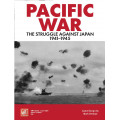Pacific War: The Struggle Against Japan, 1941-1945
GMT2114
- English
- From 14 years old
- 4h and more
- 2 player(s)
For the first time in a Pacific Theater game, size, subtlety, and ease of play has come together in a game of sharp action and historical accuracy.
Players can become familiar with the layered Pacific War systems in the solitaire Engagement scenarios, then fight their way through increasingly panoramic Battle, Campaign, and Strategic two player and multi-player Scenarios. As they learn the game's basic maneuver and combat systems, they will then layer on more advanced systems for Strategic bombing, submarine attacks on merchant shipping, search and detection, amphibious assaults, and extensive Operations driven by their command decisions.
Pacific War is a source of limitless challenge and excitement for anyone ever fascinated with the fury and vastness of the Pacific War.
Pacific War is also a time machine back to the halcyon days of the monster game. However, despite what you may have heard, Pacific War is NOT a monster game, but rather an operational World War II air-land-sea game system that lets you fight EVERY Pacific battle and campaign of significance. The original game came with 21 scenarios. This new edition will add at least half a dozen more. The game gains its monster game reputation from the fact that in order to fight all of these campaigns, you need a large number of counters (over 2000) that represent individual capital ships, cruiser divisions, destroyer squadrons, aircraft groups, and land units ranging from battalions to divisions to corps, with all units individually rated based on their historic performance.
The game map is an equal area map (two mounted maps) which is the grandfather of the Empire of the Sun map. Each hex is 100 miles and covers the entire Pacific from Hawaii to India and Alaska to Australia. The game will also come with a separate map focused on the Solomon Islands where many of the interesting and balanced scenarios occur. What made Victory Games' Pacific War unique in 1985 remains true in GMT’s 2020 edition. The design integrates strategic/operational intelligence into a telescoping time mechanic that allows campaigns to progress in a logical asymmetric flow, accompanied by tense game play. Pacific War is a deep historical simulation, so if this is not what you are looking for in a new purchase, please read no further. So, how is this level of simulation achieved?
During each monthly turn you bid command points (logistics) to determine initiative (offensive player), with the high bid then activating and launching their forces toward their objectives. Secretly, your opponent (reaction player) determines the operational intelligence level and their potential to intercept the offensive. As the offensive develops, it comes within range of enemy air and submarine forces that tactically attempt to detect the oncoming attack. The reaction player decides how to defeat the attack based on the intersection of tactical and operational intelligence coupled with available forces and logistics.
This entire sequence is set within a telescoping time scale (days to hours) that has naval units seamlessly accelerate (from 12 to 30+ knots), searches seek out the enemy, carriers launch air strikes, combat air patrols defend, culminating with torpedo and dive bomber attacks on individual naval targets. At its core, Pacific War’s game systems allows you to fight detailed carrier strikes (sequential and simultaneous) with night surface naval actions (float planes, gunfire and torpedo salvos) integrated with large scale ground offensives on the Asian mainland (e.g., Malaya, Burma, and China) and of course amphibious invasions (e.g., Java, Guadalcanal, and Leyte). If you are looking for a detailed and interactive operational simulation of the War in the Pacific, this is the game for you!
Copyright © 2025 www.philibertnet.com Legals - Privacy Policy - Cookie Preferences - Sitemap






